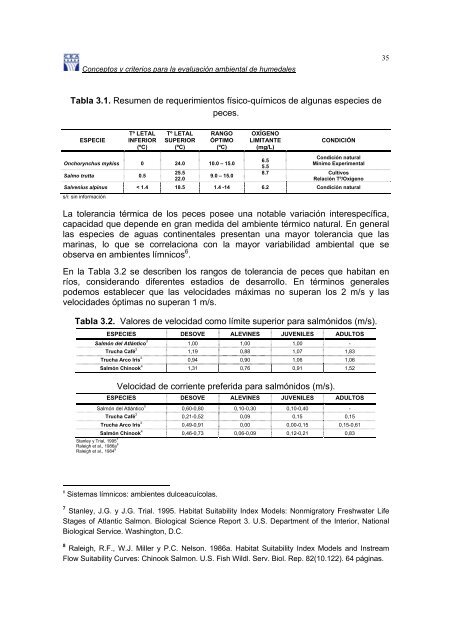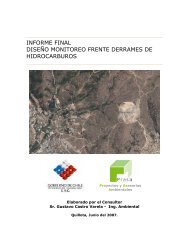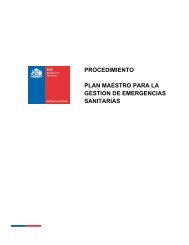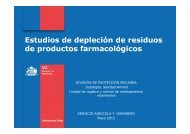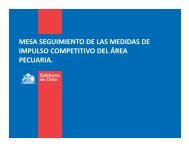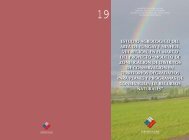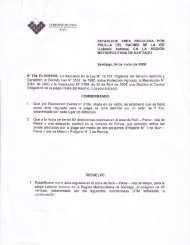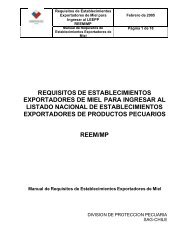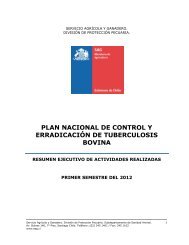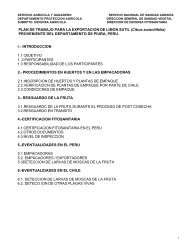Conceptos y criterios para la evaluación ambiental de humedales
Conceptos y criterios para la evaluación ambiental de humedales
Conceptos y criterios para la evaluación ambiental de humedales
You also want an ePaper? Increase the reach of your titles
YUMPU automatically turns print PDFs into web optimized ePapers that Google loves.
<strong>Conceptos</strong> y <strong>criterios</strong> <strong>para</strong> <strong>la</strong> evaluación <strong>ambiental</strong> <strong>de</strong> <strong>humedales</strong>35Tab<strong>la</strong> 3.1. Resumen <strong>de</strong> requerimientos físico-químicos <strong>de</strong> algunas especies <strong>de</strong>peces.ESPECIETº LETALINFERIOR(ºC)Tº LETALSUPERIOR(ºC)RANGOÓPTIMO(ºC)Onchorynchus mykiss 0 24.0 10.0 – 15.0Salmo trutta 0.525.522.09.0 – 15.0OXÍGENOLIMITANTE(mg/L)CONDICIÓNCondición natural6.5Mínimo Experimental5.58.7 CultivosRe<strong>la</strong>ción Tº/OxígenoSalvenius alpinus < 1.4 18.5 1.4 -14 6.2 Condición naturals/i: sin informaciónLa tolerancia térmica <strong>de</strong> los peces posee una notable variación interespecífica,capacidad que <strong>de</strong>pen<strong>de</strong> en gran medida <strong>de</strong>l ambiente térmico natural. En general<strong>la</strong>s especies <strong>de</strong> aguas continentales presentan una mayor tolerancia que <strong>la</strong>smarinas, lo que se corre<strong>la</strong>ciona con <strong>la</strong> mayor variabilidad <strong>ambiental</strong> que seobserva en ambientes límnicos 6 .En <strong>la</strong> Tab<strong>la</strong> 3.2 se <strong>de</strong>scriben los rangos <strong>de</strong> tolerancia <strong>de</strong> peces que habitan enríos, consi<strong>de</strong>rando diferentes estadios <strong>de</strong> <strong>de</strong>sarrollo. En términos generalespo<strong>de</strong>mos establecer que <strong>la</strong>s velocida<strong>de</strong>s máximas no superan los 2 m/s y <strong>la</strong>svelocida<strong>de</strong>s óptimas no superan 1 m/s.Tab<strong>la</strong> 3.2. Valores <strong>de</strong> velocidad como límite superior <strong>para</strong> salmónidos (m/s).ESPECIES DESOVE ALEVINES JUVENILES ADULTOSSalmón <strong>de</strong>l Atlántico 1 1,00 1,00 1,00 -Trucha Café 2 1,19 0,88 1,07 1,83Trucha Arco Iris 3 0,94 0,90 1,06 1,06Salmón Chinook 4 1,31 0,76 0,91 1,52Velocidad <strong>de</strong> corriente preferida <strong>para</strong> salmónidos (m/s).ESPECIES DESOVE ALEVINES JUVENILES ADULTOSSalmón <strong>de</strong>l Atlántico 1 0,60-0,80 0,10-0,30 0,10-0,40 -Stanley y Trial, 1995 7Raleigh et al., 1986a 8Raleigh et al., 1984 9Trucha Café 2 0,21-0,52 0,09 0,15 0,15Trucha Arco Iris 3 0,49-0,91 0,00 0,00-0,15 0,15-0,61Salmón Chinook 4 0,46-0,73 0,06-0,09 0,12-0,21 0,836 Sistemas límnicos: ambientes dulceacuíco<strong>la</strong>s.7 Stanley, J.G. y J.G. Trial. 1995. Habitat Suitability In<strong>de</strong>x Mo<strong>de</strong>ls: Nonmigratory Freshwater LifeStages of At<strong>la</strong>ntic Salmon. Biological Science Report 3. U.S. Department of the Interior, NationalBiological Service. Washington, D.C.8 Raleigh, R.F., W.J. Miller y P.C. Nelson. 1986a. Habitat Suitability In<strong>de</strong>x Mo<strong>de</strong>ls and InstreamFlow Suitability Curves: Chinook Salmon. U.S. Fish Wildl. Serv. Biol. Rep. 82(10.122). 64 páginas.


